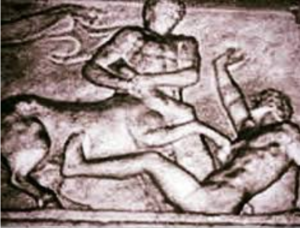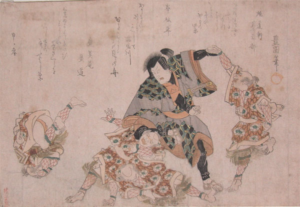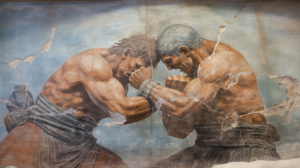In this article, we delve into the dynamic interplay between martial arts, including Japanese and Brazilian Jiu-Jitsu, and the visual arts. This exploration covers historical contexts, highlights classic examples, and dissects the powerful allure of submission holds in the physical struggles depicted in art.
Introduction
In the world of martial arts, the intricate dance of grappling has long been a captivating subject for visual artists. It’s a spectacle that marries strength and technique, a balance of power and finesse that’s as elegant as it is deadly. This fusion of combat and grace has found its way into various forms of art, from painting to sculpture, photography to film.
Artists are drawn to the raw intensity of the struggle and the intimate connection between opponents locked in combat. It’s a unique blend of athleticism and artistry, a testament to the human body’s capability and resilience, making it a fascinating subject for artistic exploration.
Historical Context of Martial Arts in Visual Arts
The historical context artistic expression of martial arts traces back centuries, where grappling and submissions were depicted in various forms of artwork. This rich lineage has evolved and adapted alongside the progression of the ages, resulting in a myriad of stylistic interpretations.
This section will explore this evolution, offering a comprehensive understanding of the aesthetic forms of martial arts in visual arts.
Ancient Depictions of Grappling and Submissions

Despite the lack of technological advancements, ancient civilizations depicted grappling and submission techniques in their art with remarkable precision and detail. These depictions provide a unique window into the world of ancient martial arts, demonstrating that the practice of grappling and submissions reaches far back into human history.
- Ancient Egypt: Hieroglyphics and wall paintings frequently depict soldiers and wrestlers engaged in what appear to be grappling holds.
- Ancient Greece: Vases and statues from this period often show athletes in the midst of a pankration match, a martial art that included both striking and grappling elements.
- Ancient Japan: Early Japanese art includes representations of samurai using jiu – jitsu-like techniques on the battlefield.
These examples underscore the universal and timeless appeal of the grappling aesthetic.

Medieval and Renaissance Interpretations
Depicting the raw power and strategy of martial arts, artists during the Medieval and Renaissance periods incorporated submission holds into their works, reflecting the cultural importance of combat skills during these eras.
- In Medieval art, knights were often shown utilizing holds in battles.
- Renaissance artists, inspired, began emphasizing the elegance of these holds.
- These depictions influenced later art and current understanding of martial arts in antiquity.
Eastern Vs. Western Artistic Representation
Transitioning from Medieval and Renaissance periods, the artistic representation of martial arts in the East and West diverged significantly, reflecting distinctive cultural values and philosophies.
Western art embraced realistic depictions, highlighting physical prowess and victory.
Conversely, Eastern art focused on the spiritual aspect, showcasing harmony, inner strength, and self-discipline, thereby underlining the philosophical depth of martial arts.
Modern Interpretations of Jiu Jitsu in Art

The integration of Brazilian Jiu-Jitsu into modern visual arts, particularly in films like “John Wick”, represents a significant evolution in combat portrayal. BJJ, alongside Judo, adds realism and technical depth to the action scenes through out the film. This trend not only enhances the visual experience but also reflects a growing appreciation of diverse martial arts, bringing new dimensions to storytelling and physical expression in mainstream culture.
Brazilian Jiu Jitsu and Grappling Tattoos
Jiu Jitsu, a martial art with deep historical roots, has long been a source of inspiration in the world of body art. BJJ has elegantly collided with tattoo culture, and this joining is etched onto skin of countless devotees, capturing its essence in stunning designs. From traditional Japanese styles to modern interpretations, these tattoos embody the strength, discipline, and artistry of Jiu Jitsu. If you are interested in learning more about Brazilian Jiu-Jitsu Tattoos, or maybe getting some ideas for a new piece, check out our article that focuses on that.
Famous examples of grappling in art
In our exploration, we’ll encounter several renowned pieces of art that vividly showcase grappling techniques and submission holds. These pieces emanate from different eras and cultures, yet all embrace the dynamism and physicality of combat.
- ‘The Wrestlers’ by Honoré Daumier: This 19th-century painting features two men locked in a fierce wrestling match, evoking the raw physicality of the sport.
- ‘Heracles and Antaeus’ by Antonio del Pollaiolo: A classic example from Renaissance art, it depicts the mythological struggle between Heracles and Antaeus, capturing a dramatic moment of grappling.
- Japanese woodblock prints: These often depicted scenes from sumo wrestling, a sport steeped in grappling techniques.
These works of art not only illustrate the aesthetic appeal of grappling but also provide a historical perspective on the sport.
Conclusion

It’s clear that grappling’s raw physicality and intricate techniques resonate deeply in artistic expression, transcending time and culture. This exploration of submission holds in art has unveiled a fascinating intersection of physical struggle and aesthetic beauty.
As seen in numerous examples, artists have long been captivated by the dynamic tension and dramatic interplay inherent in grappling. The intensity of the struggle, the balance of power, and the display of human endurance and resilience are all palpable in these works of art.
The grappling aesthetic serves as a powerful metaphor, reflecting the human condition and societal dynamics. It’s a testament to the enduring allure of this aesthetic that it continues to inspire artists today, thus preserving the art of grappling for future generations.